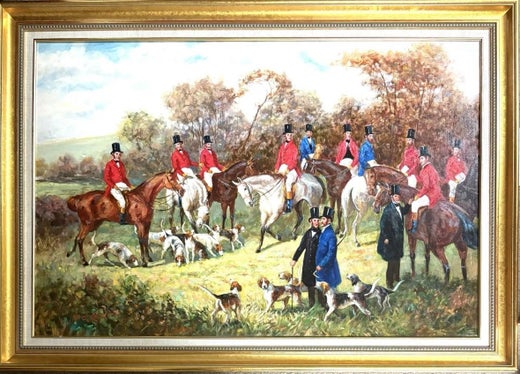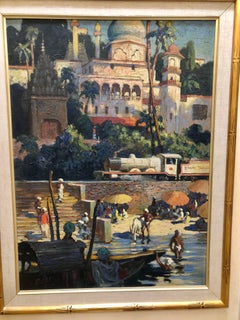Want more images or videos?
Request additional images or videos from the seller
1 of 11
Jack LevineJack Levine WW11 Painting
Price:$4,850
$6,250List Price
About the Item
- Creator:Jack Levine (1915, American)
- Dimensions:Height: 11 in (27.94 cm)Width: 14 in (35.56 cm)
- Medium:
- Movement & Style:
- Period:
- Condition:
- Gallery Location:San Francisco, CA
- Reference Number:1stDibs: LU1378213191512
Jack Levine
Jack Levine was an American social realist painter and printmaker, born and raised in Boston. He enrolled in art classes at the Museum Fine Arts School of Boston and came under the influence of Dr. Denman Ross of Harvard University, who recognized his talent and gave him free art lessons. He was especially interested in the Old Masters, at the Fogg Museum, at Harvard. In 1935, he became a W.P.A. artist, using his experience growing up in a lower-class neighborhood, in his subject matter.
About the Seller
4.9
Gold Seller
Premium sellers maintaining a 4.3+ rating and 24-hour response times
1stDibs seller since 2020
553 sales on 1stDibs
Typical response time: 5 hours
Authenticity Guarantee
In the unlikely event there’s an issue with an item’s authenticity, contact us within 1 year for a full refund. DetailsMoney-Back Guarantee
If your item is not as described, is damaged in transit, or does not arrive, contact us within 7 days for a full refund. Details24-Hour Cancellation
You have a 24-hour grace period in which to reconsider your purchase, with no questions asked.Vetted Professional Sellers
Our world-class sellers must adhere to strict standards for service and quality, maintaining the integrity of our listings.Price-Match Guarantee
If you find that a seller listed the same item for a lower price elsewhere, we’ll match it.Trusted Global Delivery
Our best-in-class carrier network provides specialized shipping options worldwide, including custom delivery.You May Also Like
“Message” oil painting, american realist, figurative, interior, contemporary
Located in Sag Harbor, NY
Signed "Levin" on lower right corner
"Message" shows two people in an office with a bird in between them, flying in from the window. There is something uncanny about this image. Per...
Category
21st Century and Contemporary American Realist Figurative Paintings
Materials
Canvas, Oil
Mid Century Figurative Portrait of a Boy with Toy Car
By Ralph Edward Joosten
Located in Soquel, CA
Realistic mid century portrait of a boy playing with an antique toy car by Ralph Joosten (American, 1928-2009). Signed "R. Joosten" in the lower left ...
Category
1960s American Realist Portrait Paintings
Materials
Canvas, Oil
$1,000 Sale Price
20% Off
H 24 in W 20 in D 0.75 in
Large Scale 1920s Portrait of Florence Foster Jenkins, Amateur Soprano Singer
Located in Soquel, CA
A fine, large-scale portrait of a Philadelphia lady, fabled soprano singer Florence Foster Jenkins, by Richard Langtry Partington (American, 19...
Category
1920s American Realist Portrait Paintings
Materials
Linen, Oil
$4,400 Sale Price
20% Off
H 52 in W 32 in D 1 in
Portrait of a Man with Blue Eyes
By Ralph Edward Joosten
Located in Soquel, CA
Realistic portrait oil painting on canvas of a man in a suite and tie by Ralph Edward Joosten (American, 1928-2009). Unsigned and unframed without glass. Image size: 24"H x 18"W.
M...
Category
Late 20th Century American Realist Portrait Paintings
Materials
Linen, Oil
$1,000 Sale Price
20% Off
H 24 in W 18 in D 0.75 in
“Unzipping” hyperrealist oil painting, teeth of zipper, minimalistic, framed
By Anthony Mastromatteo
Located in Sag Harbor, NY
An oil painting of what appears to be a closed zipper - it's metal teeth interlocking from the top of the panel, to the bottom, bisecting the white background.
Signed "Mastromatteo...
Category
21st Century and Contemporary American Realist Paintings
Materials
Oil, Panel
WPA "New Americans" Exceptional Antique 1941 WPA Exhibited Carnegie Painting
Located in Exton, PA
Monumental, important WPA painting by Percy Albee. The painting is oil canvas measuring 36" x 48". Titled verso "New Americans", this WPA painting was exhibited at the Carnegie Insti...
Category
1940s American Realist Figurative Paintings
Materials
Oil
$4,800 Sale Price
56% Off
H 40 in W 52 in D 2 in
Gloucester P-Town Pyle School Painting Henry J Peck - Portugese Fisherman
Located in Exton, PA
New England coastal scene painting by Henry Jarvis Peck. The artist attended the Rhode Island School of Design, studied with George Loftus Noyes, and moved to Wilmington Delaware in ...
Category
Early 20th Century American Realist Figurative Paintings
Materials
Oil
$1,760 Sale Price
20% Off
H 33 in W 24 in D 3 in
Before the Deluge, Republican Headquarters before Landon lost to Roosevelt.
Located in Marco Island, FL
In 1936, Alfred Landon and Frank Knox were the Republican candidates for President and Vice President. They were defeated in a landslide by Franklin Roosevelt. Clyde Singer captures ...
Category
1930s American Realist Figurative Paintings
Materials
Oil, Canvas
Women's City Club, Youngstown, Ohio. American Historical Scene Painting.
Located in Marco Island, FL
An accomplished American Scene painter, Clyde Singer successfully captured everyday life during his long career. A unique aspect of American life is depicted in this painting, entitl...
Category
1940s American Realist Landscape Paintings
Materials
Oil, Board
$32,000
H 19 in W 27 in D 3 in
Interior J&L Works, Pittsburgh, Pennsylvania American Industrial Scene Painting
Located in Marco Island, FL
An interior scene of industrial America where workers kept the production of steel going in Pittsburgh, Pennsylvania. This detailed and atmospheric painting shows the hard work and ...
Category
20th Century American Realist Interior Paintings
Materials
Oil, Board
$4,800
H 22 in W 26 in D 1 in
More From This Seller
View AllJames Elliott Bama Oil on Board "And Then There Was One"
Located in San Francisco, CA
James Elliott Bama was born in 1926 in New York City. He studied at the Arts Student League and became a very successful illustrator for magazines like ...
Category
1960s American Realist Figurative Paintings
Materials
Oil
19th Century American School Oil on Board
Located in San Francisco, CA
Charming 19th Century oil on board. Adorable young child either daydreaming or posing while leaning on a fence with the moon in background. Looks like it could possibly
be done by ...
Category
19th Century American Realist Figurative Paintings
Materials
Oil
Raphael Soyer "George the Iceman Woolf"
By Raphael Soyer
Located in San Francisco, CA
Raphael Soyer: 1899-1987. Very important and well listed American artist. One of the early social realist painters. He was born in Russia, but his family was deported by the Tsar in ...
Category
Mid-20th Century American Realist Figurative Paintings
Materials
Oil
Manning de Villenueve Lee Early 20th Century India
Located in San Francisco, CA
Manning de Villenueve Lee:1894-1980. Well listed American painter and illustrator with Auction records up to $22,500. This spectacular painting is one of our favorites. Probably pain...
Category
1940s American Realist Figurative Paintings
Materials
Oil
Harry Roseland “Silent Treatment”
By Harry Herman Roseland
Located in San Francisco, CA
Harry Roseland: 1866-1950. Well listed American artist with auction results over $250,000. This fabulous incredibly detailed oil on board measures 11 inches wide by 8 inches high. Th...
Category
Early 20th Century American Realist Figurative Paintings
Materials
Oil
Raymond Howell, Chinese Dim Sum Feast, 1979, Oil Painting on Masonite
Located in San Francisco, CA
Raymond Howell, Chinese Dim Sum Feast, 1979
Oil on masonite
28" x 36" unframed, 35.5" x 43. 75" framed
Biography from Raymond Howell website:
Raymon...
Category
20th Century American Realist Figurative Paintings
Materials
Masonite, Oil
Recently Viewed
View AllMore Ways To Browse
Portrait Of Soldier
Canadian Pop Art
Oil Painting Mythological
Oil Paintings Beer
Pasadena Painting
Portrait Of Pope
Apollo Painting
Descent From The Cross
Devil Painting
Michael Wilkinson
Michelle Oil Painting
Roma Painting
Western Native American
Bruce Sargeant Painting
Jeff Hamilton
Magic Realism Art
Mother Daughter Art
Oil Painting Children Playing

